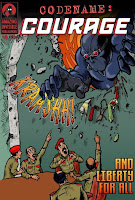So,
Superman’s my favorite superhero.........besides Batman. Alright, so Batman’s
my actual favorite superhero, but Supes is a very close second. Whenever the
brooding, gothic, hard-hitting escapades of The Dark Knight begin to wear me
down, the inspiring, diligent and sunny adventures of the Man of Tomorrow help
me to catch my breath and not look at the world with such cynical and
pessimistic eyes. DC’s philosophy of aspiration rather than relativity has
always been close to me since I was a kid, especially a creative kid. However,
Superman being unrelatable has always been a surface assessment at best.
Superman’s origin is the original immigrant story and his alien heritage pulled
the “fear of fitting in” card long before the X-Men hit the scene. In spite of
this however, he hasn't had the same recent luck that Batman has had in film.
 |
The Batman
and Superman films had gone through an interesting parallel during the course
of both their franchises. Prior to reboots, they both had four films under
their belt, each one garnering significantly less critical praise than the
previous entry and by the end of both Superman
IV: The Quest for Peace and Batman
& Robin, the franchises seemed stuck in limbo for the time being, with
multiple attempts to re-oil the machine on both sides to no avail. But, the
Caped Crusader struck a chord with audiences once again with Christopher Nolan
helming Batman Begins. But, the same
couldn’t be said for Bryan Singer’s admirable but misguided Superman Returns, a half-reboot,
half-sequel that failed to bring the world’s first superhero back into the
spotlight. Because of this fumbling, the series had been halted with failed
attempts to produce a sequel to Returns
and a desire to start completely from scratch much like the increasingly
successful Dark Knight Trilogy. So
here we are.
Man of Steel is the freshly rebooted take on the
character written by David S. Goyer (Blade,
The Dark Knight Trilogy) and directed
by Zack Snyder (300, Watchmen), and produced by Christopher
Nolan himself, although his stake on the actual film is very exaggerated. The
film re-tells the origin of Kal-El/Clark Kent/Superman in a modern context as
Clark travels the world to discover himself whilst the threat of General Zod
and a militia of surviving Kryptonians travel to Earth in search for him.
Now, the
origin has been done a million times, this isn’t news to anyone, including
myself. The Man of Steel, Superman: Birthright, Superman: Secret Origin, the list goes
on. However, this is the first time audiences have experienced the origin on
film in forty years, so I don’t think a renewal is unwarranted. As far the
origin goes in this film, I felt the weight of Clark’s turmoil and comprehension
throughout his young life, even if it doesn’t go as in-depth with his history
as something like Batman Begins did
for Bruce Wayne. But, considering the lack of enthusiasm and weariness towards
superhero origin stories, I found it refreshing that we begin on Krypton and
transition to an adult Clark travelling the world and his childhood is
illustrated through flashbacks as the narrative progresses. Some may criticize
this as being fragmented, but I found it an interesting change of pace and each
stroll down memory lane felt natural and contextual to the situation whenever
it occurred.
 |
| Russell Crowe was a great Jor-El, he actually gave his performance a bit of effort for once. |
We’ve done
away with the distracting miscasts of Brandon Routh and (especially) Kate
Bosworth and now have the very likeable Henry Cavill and Amy Adams as Clark and
Lois Lane, respectively. Not since Christopher Reeve and Margot Kidder have
there been such serviceable and accurate portrayals of both these characters.
Henry Cavill portrays a more brooding Superman, no doubt about that, which may
put off fans and casual viewers alike, but considering the events that surround
him and the purpose of the film being that he’s on the road to becoming the
hero he needs to be, it made sense. Besides, he’s not all frowns and sighs, there
are plenty of moments of levity where Cavill can just stand and pull off that
trademark smile so few actors can pull off.
From an
aesthetical standpoint, this is a gorgeous looking film; Zack Snyder lends his
cinematographic prowess to what is essentially the Superman film that we’ve
been long overdue. The film is shot entirely on single-camera, and handheld, at
that. Speaking of things belated to us, Man
of Steel delivers non-stop ounces of mayhem, destruction and a threat
worthy of the character for the first time since 1980, when Superman II hit theaters. The final
forty minutes of the film are relentless but not without earning such a
breathtaking climax after thirty-three years of dead space from this franchise.
I believe the
film is worth it. I also believe the marketing is somewhat misleading, and the
tone is more in line with later trailers, so I’d recommend not getting
overhyped. For a first chapter in what will hopefully now become a recharged
series, this film was a blast, especially after the polarizing and
unsatisfactory Iron Man 3. It is most definitely a relevant but faithful take
on the timeless character, even if it’s not as deep as you might as expect. But
hey, after Superman III, IV, and Returns, this comes as blessing. As a huge
Superman fan, it’s the most fun I’ve had so far this summer. There will be
repeat viewings, and this will sit right next to my Superman: The Animated
Series volumes and Superman Collector’s Edition DVD, where it belongs. 8.5 out
of 10.

.jpg)
































